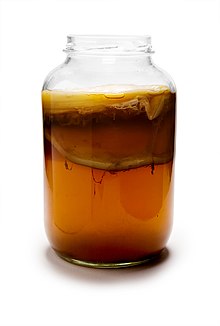

Symbiotic culture of bacteria and yeast (SCOBY) is a culinary symbiotic fermentation culture (starter) consisting of lactic acid bacteria (LAB), acetic acid bacteria (AAB), and yeast which arises in the preparation of sour foods and beverages such as kombucha.[1] Beer and wine also undergo fermentation with yeast, but the lactic acid bacteria and acetic acid bacteria components unique to SCOBY are usually viewed as a source of spoilage rather than a desired addition.[2][3] Both LAB and AAB enter on the surface of barley and malt in beer fermentation and grapes in wine fermentation; LAB lowers the pH of the beer/wine while AAB takes the ethanol produced from the yeast and oxidizes it further into vinegar, resulting in a sour taste and smell.[2][3] AAB are also responsible for the formation of the cellulose SCOBY.[1]
In its most common form, SCOBY is a gelatinous, cellulose-based biofilm or microbial mat found floating at the container's air-liquid interface. This bacterial cellulose mat is sometimes called a pellicle.[4] SCOBY pellicles, like sourdough starters, can serve the purpose of continuing the fermentation process into a new vessel and reproducing the desired product.[4] This can be attributed to SCOBY's ability to house not only the symbiotic growth, but a small amount of the previous media and product due to its ability to absorb water.[1] SCOBYs can vary greatly in cell density within the biofilm due to fermentation conditions, leading to possible variations in the end product; numerous studies are currently taking place to determine the optimal ratio of SCOBY, if any, to liquid culture to ensure highest product consistency, as there are no standard operating procedures in place.[4] Further information such as the organisms and culture conditions necessary to ferment and form a SCOBY, biofilm characteristics, and applications in foods and beverages with specific emphasis in kombucha can be found below.[5]
- ^ a b c Villarreal-Soto, Silvia Alejandra; Beaufort, Sandra; Bouajila, Jalloul; Souchard, Jean-Pierre; Taillandier, Patricia (March 2018). "Understanding Kombucha Tea Fermentation: A Review: Understanding Kombucha tea fermentation…". Journal of Food Science. 83 (3): 580–588. doi:10.1111/1750-3841.14068. PMID 29508944.
- ^ a b Bokulich, N. A.; Bamforth, C. W. (2013-06-01). "The Microbiology of Malting and Brewing". Microbiology and Molecular Biology Reviews. 77 (2): 157–172. doi:10.1128/MMBR.00060-12. ISSN 1092-2172. PMC 3668669. PMID 23699253.
- ^ a b "Lactic Acid Bacteria and Wine Spoilage". Midwest Grape and Wine Industry Institute. Retrieved 2020-05-12.
- ^ a b c May, Alexander; Narayanan, Shrinath; Alcock, Joe; Varsani, Arvind; Maley, Carlo; Aktipis, Athena (2019-09-03). "Kombucha: a novel model system for cooperation and conflict in a complex multi-species microbial ecosystem". PeerJ. 7: e7565. doi:10.7717/peerj.7565. ISSN 2167-8359. PMC 6730531. PMID 31534844.
- ^ "Homemade Kombucha". Fonsly. 13 November 2019. Retrieved 1 August 2021.
© MMXXIII Rich X Search. We shall prevail. All rights reserved. Rich X Search
